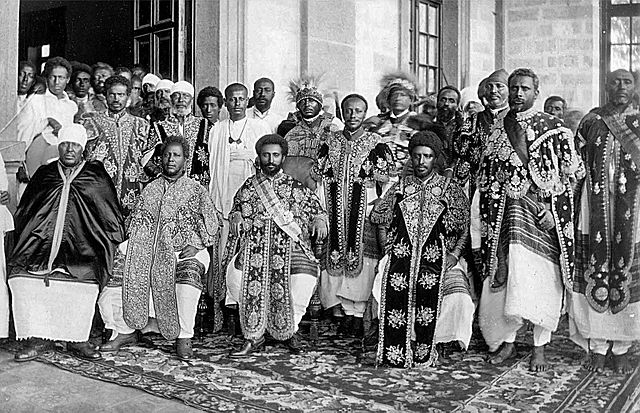Loading AI tools
List of royal and noble titles in the Ethiopian Empire From Wikipedia, the free encyclopedia
Until the end of the Ethiopian monarchy in 1974, there were two categories of nobility in Ethiopia and Eritrea. The Mesafint (Ge'ez: መሳፍንት masāfint, modern mesāfint, singular መስፍን masfin, modern mesfin, "prince"), the hereditary royal nobility, formed the upper echelon of the ruling class. The Mekwanint (Ge'ez: መኳንንት makʷanint, modern mekʷanint, singular መኰንን makʷanin, modern mekʷanin or Amharic: መኮንን mekonnen, "officer") were the appointed nobles, often of humble birth, who formed the bulk of the aristocracy. Until the 20th century, the most powerful people at court were generally members of the Mekwanint appointed by the monarch, while regionally, the Mesafint enjoyed greater influence and power. Emperor Haile Selassie greatly curtailed the power of the Mesafint to the benefit of the Mekwanint, who by then were essentially coterminous with the Ethiopian government.


The Mekwanint were officials who had been granted specific offices in the Abyssinian government or court. Higher ranks from the title of Ras descending through to Balambaras were also bestowed upon members of the Mekwanint. A member of the Mesafint, however, would traditionally be given precedence over a member of the Mekwanint of the same rank. For example, Ras Mengesha Yohannes, son of Emperor Yohannes IV and thus a member of the Mesafint, would have outranked Ras Alula Engida, who was of humble birth and therefore a member of the Mekwanint, even though their ranks were equal.
There were also parallel rules of precedence, primarily seniority based on age, on offices held, and on when they each obtained their titles, which made the rules for precedence rather complex. Combined with the ambiguous position of titled heirs of members of the Mekwanint, Emperor Haile Selassie, as part of his programme of modernising reforms, and in line with his aims of centralising power away from the Mesafint, replaced the traditional system of precedence with a simplified, Western-inspired system that gave precedence by rank, and then by seniority based when the title had been assumed – irrespective of how the title was acquired.[1]

Although several kings of Aksum used this style, until the restoration of the Solomonic dynasty under Yekuno Amlak, rulers of Ethiopia generally used the style of Negus, although "King of Kings" was used as far back as Ezana of Axum (320's–360 CE/AD).
The full title of the Emperor of Ethiopia was Negusa Nagast and Seyoume Igziabeher (Ge'ez: ሥዩመ እግዚአብሔር; "Elect of God"). The title Moa Anbessa Ze Imnegede Yehuda ("Conquering Lion of the Tribe of Judah") always preceded the titles of the Emperor. It was not a personal title but rather referred to the title of Jesus and placed the office of Christ ahead of the Emperor's name in an act of Imperial submission. Until the reign of Yohannes IV, the Emperor was also Neguse Tsion (Ge'ez: ንጉሠ ጽዮን, nəgusä tsiyon, "King of Zion"), whose seat was at Axum, and which conferred hegemony over much of the north of the Empire.
The Emperor was referred to by the dignities of the formal Girmawi (Ge'ez: ግርማዊ, gərəmawi, "His Imperial Majesty"), in common speech as Janhoy[nb 1] (Ge'ez: ጃንሆይ janihoy, "Your [Imperial] Majesty", or lit. "sire"), in his own household and family as Getochu (our Master in the plural), and when referred to by name in the third person with the suffix of Atse (effectively "Emperor", i.e. Atse Menelik).
All formal speech concerning the Emperor was in the plural, as was his own speech; Haile Selassie, for instance, referred to himself in the first-person plural at all times, even in casual conversation and when speaking in French (however this was not the case when he spoke in English, in which he was not fully fluent).[2]
The Negesta Nagastat (Ge’ez: ንግሥተ ነገሥታት nəgəstä nägästât) was Empress Regnant in her own right, literally "Queen of Kings", or "Queen of Queens", or "female ruler of an empire."
Zewditu (reigned 1917–1930) was the only woman to be crowned in Ethiopia in her own right since ancient times. Rather than take the title itege, which was reserved for empress consorts, Zewditu was given the feminine version of nigusa nigist to indicate that she reigned in her own right. She was accorded the dignity of Girmawit ("[Her] Imperial Majesty") and the title of Siyimta Igzi'abher (Ge’ez: ሥይምተ እግዚአብሔር səyəmtä ’əgziabhēr, "Elect of God"). She was commonly referred to as nigist, translated as "Queen". The 1955 Constitution of Ethiopia excluded women from the succession to the throne so this title was effectively abolished.
An Itege (Amharic: እቴጌ ’ətēgē) was an Empress Consort. This refers to the wives of reigning emperors.
Empresses were generally crowned as consorts by the emperor at the Imperial Palace. However, Taytu Betul, consort of Menelik II, became the first Itege to be crowned by the Emperor at church rather than at the Palace. Her coronation took place on the second day of the emperor's coronation holiday. Menen Asfaw became the first Itege to be crowned by the archbishop on the same day and during the same ceremony as her husband, Haile Selassie. The Itege was entitled to the dignity of Girmawit ("Her/Your Imperial Majesty").
A Negus (Ge'ez: ንጉሥ nəgus, "king") was a hereditary ruler of one of Ethiopia's larger provinces, over whom collectively the monarch ruled, thus justifying his imperial title. The title of Negus was awarded at the discretion of the Emperor to those who ruled important provinces, although it was often used hereditarily during and after the Zemene Mesafint. The rulers of Begemder, Shewa, Gojjam, Wollo, all held the title of Negus at some point, as the "Negus of Shewa", "Negus of Gojjam", and so forth.
During and after the reign of Menelik II virtually all of the titles either lapsed into the Imperial crown or were dissolved. In 1914, after having been appointed "Negus of Zion" by his son Lij Iyasu, Mikael of Wollo, in consideration of the hostile feelings this provoked among much of the nobility in northern Ethiopia (particularly Le'ul Ras Seyoum Mengesha, whose family had resented being denied the title by Menelik), who were now technically made subordinate to him, instead elected to use the title of Negus of Wollo. Tafari Makonnen, who later became Emperor Haile Selassie, was bestowed the title of Negus in 1928; he would be the last person to bear the title.[citation needed]
Despite this, European sources referred to the Ethiopian monarch as the Negus well into the 20th century, switching to Emperor only after the Second World War – around the same time the name Abyssinia fell out of use in favour of Ethiopia in the west.
Leul or Leoul (Ge'ez: ልዑል lə‘ul, "Prince") was a princely style used by sons and grandson of Ethiopia's dynastic monarchs. It is equivalent to that of Your Highness and was formerly only used as a form of address. The term was introduced as an official title in 1916 by the former foreign minister Blatten Geta Heruy Wolde-Selassie; it was first applied to Dejazmatch Tafari and his wife Princess Menen, who were respectively designated Leul-Ras and Le'elt Woizero.
Le'elt (Ge'ez: ልዕልት lə‘əlt, "Princess"). This title came into use in 1916 upon the enthronement of Zewditu. Reserved at birth for daughters of the monarch and patrilineal granddaughters. Usually bestowed on the wives of Leul Ras, as well as the monarch's granddaughters in the female line upon their marriages. The notable exception to the rule was Leult Yeshashework Yilma, Emperor Haile Selassie's niece by his elder brother, who received the title with the dignity of "Highness" from Zewditu upon the princess' marriage to Leul Ras Gugsa Araya Selassie in 1918, and then again from her uncle upon his coronation in 1930 with the enhanced dignity of "Imperial Highness".
Abetohun (Amharic: አቤቶኹን abētōhun) or Abeto (Amharic: አቤቶ abētō, "Prince") – Title reserved for males of imperial ancestry. The title fell into disuse by the late 19th century. Lij Iyasu attempted to revive the title as Abeto-hoy (Amharic: አቤቶ ሆይ, "Great Prince"), and this form is still used by the current Iyasuist claimant Girma Yohannes Iyasu. Lij Tedla Melaku, an influential Ethiopian philosopher, monarchist, and a member of the Gondar-Lasta branch of the Solomonic-Zagwe Imperial House and the Shewan nobility was also invested with the title of Abeto by the Crown Council of Ethiopia in 2019.
Ras (Amharic: ራስ, romanized: ras, lit. 'head', compare with Arabic Rais) – One of the powerful non-imperial titles; historian Harold G. Marcus equates this to a duke. The combined title of Leul Ras (Amharic: ልዑል ራስ) was given to the heads of the cadet branches of the imperial dynasty, such as the Princes of Gojjam, Tigray and the Selalle sub-branch of the last reigning Shewan Branch.
An Emebet Hoy (እመቤት ሆይ ’əmäbēt hōy, "Great Royal Lady") was a title reserved for the wives of those bearing the title of Leul Dejazmach and other high ranking women of royal blood.
Alternatively, an Emebet (እመቤት ’əmäbēt, "Royal Lady") was a title reserved for the unmarried granddaughters of the monarch in the female line (they were generally granted the title of leult upon marriage), and to the daughters of the Leul Ras.
Bitwoded (Amharic: ቢትወደድ, romanized: bitwädäd, lit. 'beloved') – An office thought to have been created by Zara Yaqob who appointed two of these, one of the Left and one of the Right. These were later merged into one office, which became the supreme grade of Ras, "Ras Betwadad". Marcus equates the style to an earl.
Lij (Amharic: ልጅ, romanized: ləj, lit. 'child') – Title issued at birth to sons of members of the Mesafint, the hereditary royal nobility.
Seamless Wikipedia browsing. On steroids.
Every time you click a link to Wikipedia, Wiktionary or Wikiquote in your browser's search results, it will show the modern Wikiwand interface.
Wikiwand extension is a five stars, simple, with minimum permission required to keep your browsing private, safe and transparent.